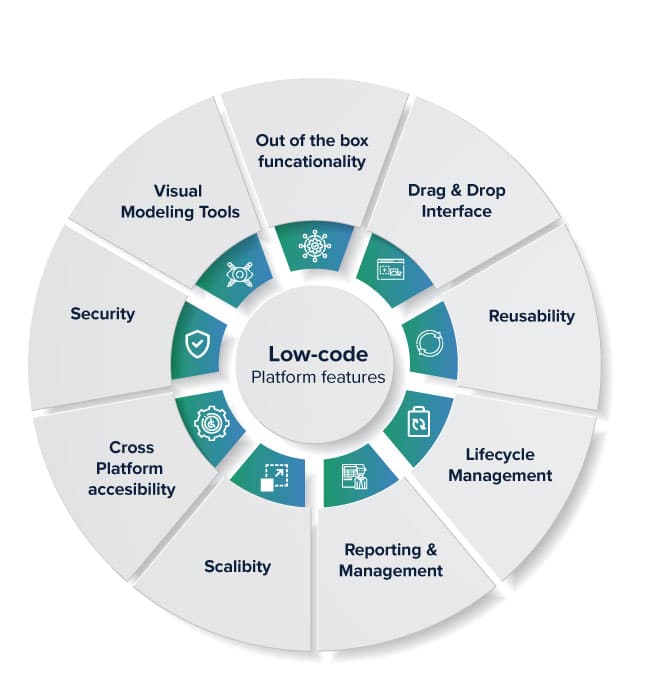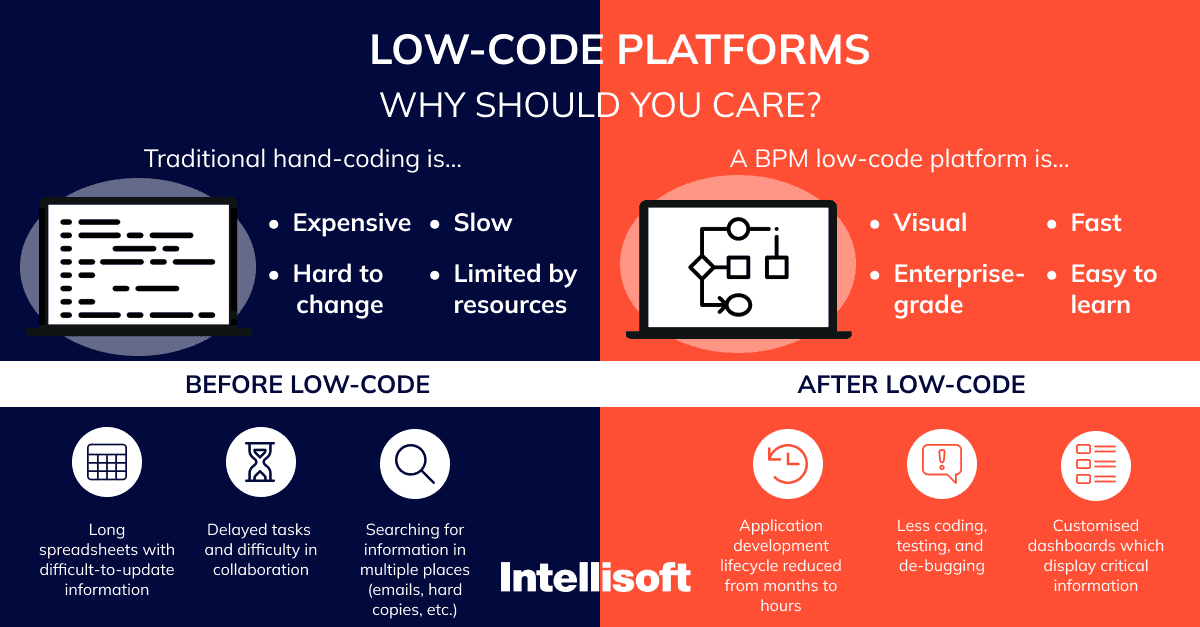Excellent Tips On Picking Low-code platforms for application development
Wiki Article
Benefits Of Low-Code Application Development In Terms Of Integration Capabilities
Low-code integration of applications has many advantages, including the ability to seamlessly integrate with multiple systems and services. Here are a few of the main advantages: Prebuilt Connectors and APIs
Wide Variety of Connectors Low-code platforms typically come with an array of connectors that are pre-built to popular enterprise applications (e.g. CRMs, databases ERPs, cloud services, etc.). It simplifies the integration with these systems.
API Integration: Many low code platforms come with integrated APIs that are built-in that allow developers to easily connect to external services and sources of data.
Easy of use:
Drag-and-Drop Interfaces: A variety of integration tasks are easily performed using drag-and–drop interfaces. This makes it feasible for developers and others who are not developers to develop complex systems with out extensive coding.
Visual Workflow Builders Visual tools to design workflows and data flows aid in understanding and establishing integrations with greater ease.
Standardized Integration Methods:
SOAP and RESTful Service : The support for web services standards like SOAP and REST makes it easy to integrate with many different systems.
OData and Other Standards: Support for standards like OData enables easy access and manipulation of data on a variety of platforms and applications.
Real-Time Data Synchronization:
Real-Time Integrations: Low-code platforms are capable of handling the real-time synchronization of data among applications, systems as well as databases. This ensures that all data is current and consistent across an organization.
Event-Driven Architectures: A few platforms offer event-driven architectures that enable applications to react in real-time whenever events occur, which is vital for dynamic applications.
Legacy System Integration:
Low-code platforms are a great source of software for integrating with legacy systems. They enable organizations to modernize IT without overhauling their existing systems.
Data Migration: Built-in tools help transfer data from outdated applications to new ones that are built on platforms that have low-code.
Third-Party service integration:
Cloud Services: Seamless Integration with Cloud Services such as AWS Azure Google Cloud and Google Cloud allows for easy deployment of applications.
Business Applications Low-code platforms allow you to integrate with various business apps like Salesforce, SAP or Microsoft Dynamics. They can create the creation of a seamless workflow for all business processes.
Simplified Data Management:
Unified Data Models: Certain lowcode platforms offer common coding models, which make it easier to manage managing data, integration and synchronization across various platforms.
Data Connectors - Connectors pre-configured to provide easy access to, and manipulation of data from diverse sources.
Security and compliance:
Low-code integration platforms meet security standards to safeguard the data during transport or in storage.
Features for Compliance - These platforms come with features that make sure that the integrations are in compliance to regulatory requirements.
Extensibility:
Low-code platforms often meet complicated integration requirements by incorporating custom scripts or code. They offer flexibility without compromising their user-friendliness.
Plug-in Ecosystem: An ecosystem of extensions and plugins can further extend the integration capabilities and allow users to add new functionalities as needed.
Low-code platforms provide a powerful tool to create interconnected, robust and scalable applications. They facilitate the process of connecting different systems, improve data flow and allow enterprises to embrace new technologies while using existing ones. Take a look at the top wavemaker.com coding for site examples including rapid app development, database in azure, application development platforms, application development platforms, rad development, app dev platform, rad application development, build a docker container, develop web application, software for app development and more.

Low-Code Apps Are Affordable.
Low-code development offers a number of advantages when it comes to cost-effectiveness. Businesses that are seeking to reduce costs can take advantage of this approach while also delivering high-quality applications. These are the main benefits: Reduced Development Costs:
Lower Coding Requirement: Lower coding platforms eliminate the requirement to code manually and save developers time as well as money. This means lower costs for labor.
We require less developers: Development that is low-code takes less time and is easier. This means there are fewer developers needed. This will drastically lower the cost of hiring and staffing.
Faster time to market:
Accelerated Development Cycle: The visual development tools and pre-built components provided by low-code platforms enable rapid application development, which allows companies to get their products on market quicker. This could result in faster revenue generation and improved position in the marketplace.
Rapid prototyping. Businesses can quickly test and create prototypes. This helps reduce time during the development phase, and enables quicker iterations dependent on the feedback of users.
Reduced Maintenance Costs
Due to their modularity as well as standard components, applications built on low-code platforms are easier to maintain. Maintenance and support cost is reduced.
Automated Updates: Many low-code software platforms manage updates and patches automatically making sure that applications remain safe and up-to date without needing extensive manual intervention.
Efficient Resource Utilization:
Contributions by non-developers: Low-code platforms allow non-developers, like business users, to be a part of the development process. This democratization enables businesses to take advantage of the skillsets of a wide spectrum of employees.
Utilizing IT resources efficiently: IT departments will be able focus on strategic projects, instead of being bogged down in mundane development tasks. This will improve the overall efficiency and productivity.
Price models that are scaleable:
Subscription-Based Pricing: A lot of low-code platforms provide flexible pricing based on subscriptions that can scale with the amount of usage. This lets businesses be able to align their spending with the actual demands and growth while avoiding significant upfront costs.
Pay-Assosiated Alternatives: Some platforms provide pay-assosiated choices. They ensure that businesses pay only for the resources utilized and are beneficial for small and new businesses with limited funds.
Reduce the cost of third-party software:
Low-code platforms are built-in with functions and integrations, which could reduce the cost of subscriptions to software and licensing.
Pre-Built Intergrations: The availability and pre-built integrations of popular systems and services reduces the requirement for custom development and saves time and money.
Better ROI
Faster Return on Investment: Rapid development, lower cost, and faster time to market mean that companies can achieve a faster ROI (ROI) on their software.
Increased Agility: Businesses are able to quickly adjust to changes in the market and changing customer needs. This helps them remain current and take advantage of opportunities that arise.
Lower Cost of Training
Low-Code Platforms have User-Friendly Interfaces. The user-friendly and intuitive interfaces cut down on the learning curve for new users. This reduces the requirement for extensive training programs.
Accessible Resources: Many low code platforms provide comprehensive training materials and tutorials as well as community assistance. These resources reduce the need for formal instruction and the associated costs.
Collaboration Streamlined:
Enhanced Collaboration Tool: The built-in collaboration tool facilitates better collaboration and communication among team members. This leads to faster development processes and also reduces the cost of projects.
Unified Development Environment (UDE): A single, unifying development environment streamlines workflows and reduces the costs and complexity of managing various tools and platforms.
The overall cost-effectiveness of software development using low-code can be attributed to its capacity to reduce maintenance and development costs as well as increase the time to market and optimize the use of resources and also provide flexible pricing models. This combination of factors offers firms significant financial benefits, making Low-code an attractive choice for companies looking to increase their development budgets while still creating strong and flexible applications. Take a look at the top wavemaker.com coding for blog recommendations including application modernization software, push notifications, low code development platforms, app platforms, develop web application, application modernization software, driver jdbc, microsoft azure sql, azure sql server, rad application development and more.

Benefits Of Low-Code Application Development In Terms Of Community Support And Vendor Support
Low-code platforms for application development provide significant advantages in terms of vendor support and community, which are crucial for ensuring the success of implementation, continuous maintenance, and continual enhancement of applications. Support for Vendors
Comprehensive Technical Support:
Support Teams: Several Low-Code platforms have a to a dedicated support team that assist with technical issues, advice and troubleshooting.
Some vendors provide support 24 hours a day. This is especially beneficial to global businesses with multiple time zones.
Training and Onboarding
Vendors offer structured learning programs such as webinars, tutorials and certifications to help users become familiarized with the system.
Many companies offer customized onboarding that helps customers to use the platform efficiently and tailor it to the needs of their customers.
Regular Updates and enhancements:
Continuous Improvement: Lowcode platform vendors usually issue regular updates that include new features, performance enhancements and security patches. This is a way to ensure that the platform is up-to date and safe.
Feedback integration: Vendors will frequently incorporate feedback from users during their development process to ensure that the platform is able to meet the changing requirements of users.
Comprehensive Documentation:
Detailed Documentation: Extensive and well-organized documents are usually available for download, covering everything from basics to advanced customization, which assists users in finding solutions independently.
API References API documentation can aid developers to customize and integrate their applications using the Low-Code platform.
Professional Consulting Services
Expert Consulting: Many vendors offer consulting services that aid users with complicated implementations and designs for architecture and strategic planning.
Custom Development Services: Some vendors offer custom development services to develop specific features or integrations that aren't available in the standard package.
Community Support
Active User Groups:
Discussion boards and forums A number of low-code platforms have lively online communities that allow users to discuss ideas, ask questions, and collaborate.
User Groups and Meetups: Both local and virtual user groups and meetups provide opportunities to learn, network, and share experiences with others.
Knowledge Sharing and collaboration:
Community-Contributed Resources: Users often share templates, modules, and extensions that they have developed, which can be reused or adapted by others, accelerating development and innovation.
Crowdsourced Solutions: The collective wisdom, experience and expertise of a community may be an effective tool for troubleshooting and finding creative solutions.
Learning and Development:
Community-Led training: Many communities offer workshops, webinars and training sessions led by knowledgeable users.
Tutorials and online courses Community members frequently create and share online tutorials, courses, and how-to guide, improving the education resources available to all users.
Feedback and Influence
Community forums are usually an area where businesses can get feedback from the community. This information can be utilized to design enhancements or new features.
Beta Testing Programs - Members of the community may be able to take part in the beta testing program. They will get an early look at new features, and the chance to influence the future of the system.
Recognition and Encouragement
Community Recognition Programs: Many vendors have recognition programs to acknowledge the contributions of active members of the community for example, MVP (Most Valuable Professional) programs.
Peer support: Community members tend to be willing to provide support to peers, providing their knowledge and guidance to those who may be less knowledgeable. They foster a collaborative environment through encouraging cooperation and creating a positive atmosphere.
The overall result is solid vendor with active and engaged communities. They provide a comprehensive environment for support of low-code applications development. The combination of strong vendor support as well as an active, engaged community provides an entire support network for development of low-code applications.
